This document discusses statement-level control structures in programming languages. It covers the evolution of control statements from FORTRAN to modern languages. Key topics include compound statements, selection statements like if/else and switch/case, and iterative statements like for, while, and do-while loops. The document analyzes design choices for these structures and provides examples from languages like ALGOL, Pascal, C, Java and others. It also discusses unconditional branching, guarded commands, and iteration based on data structures.
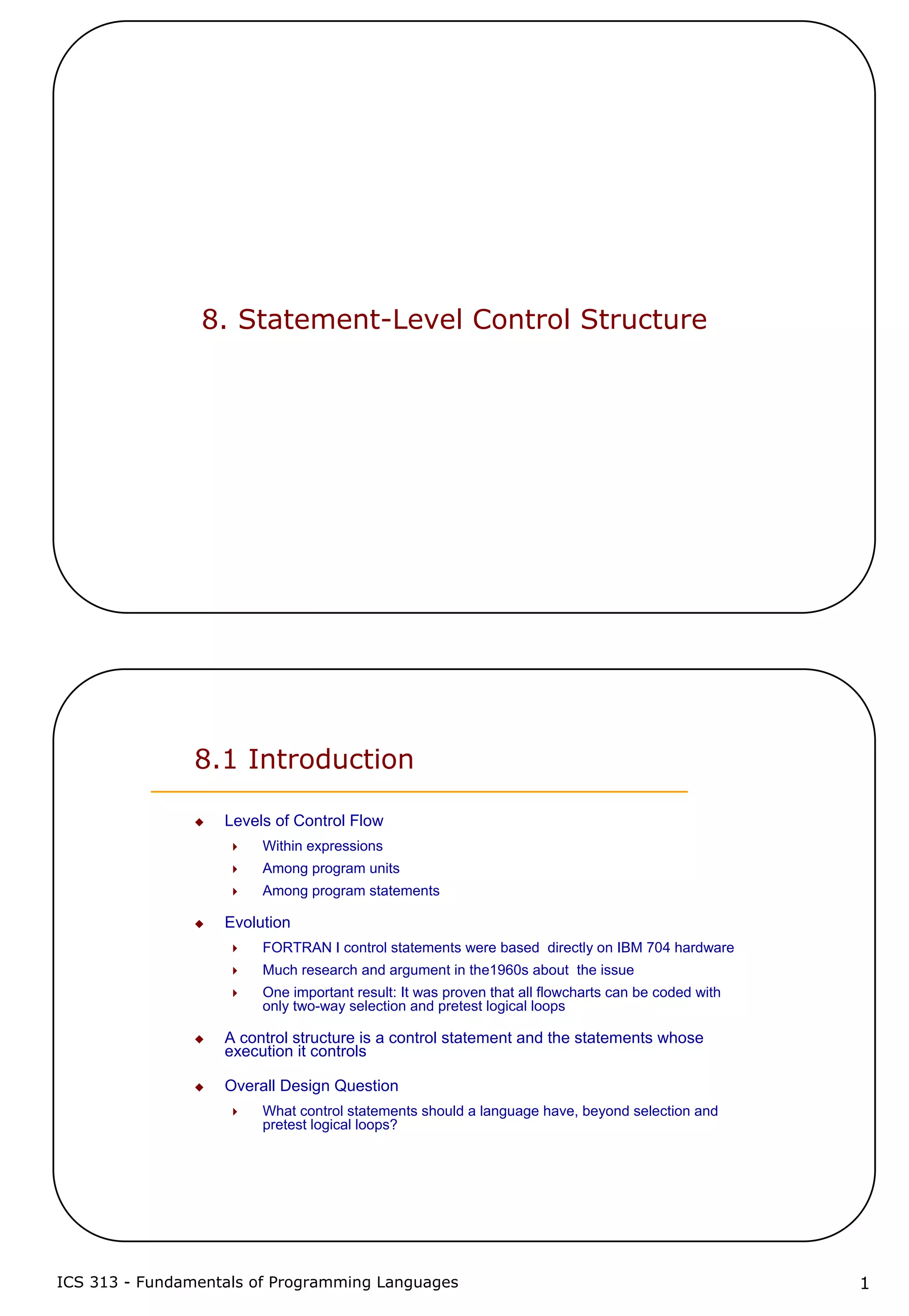
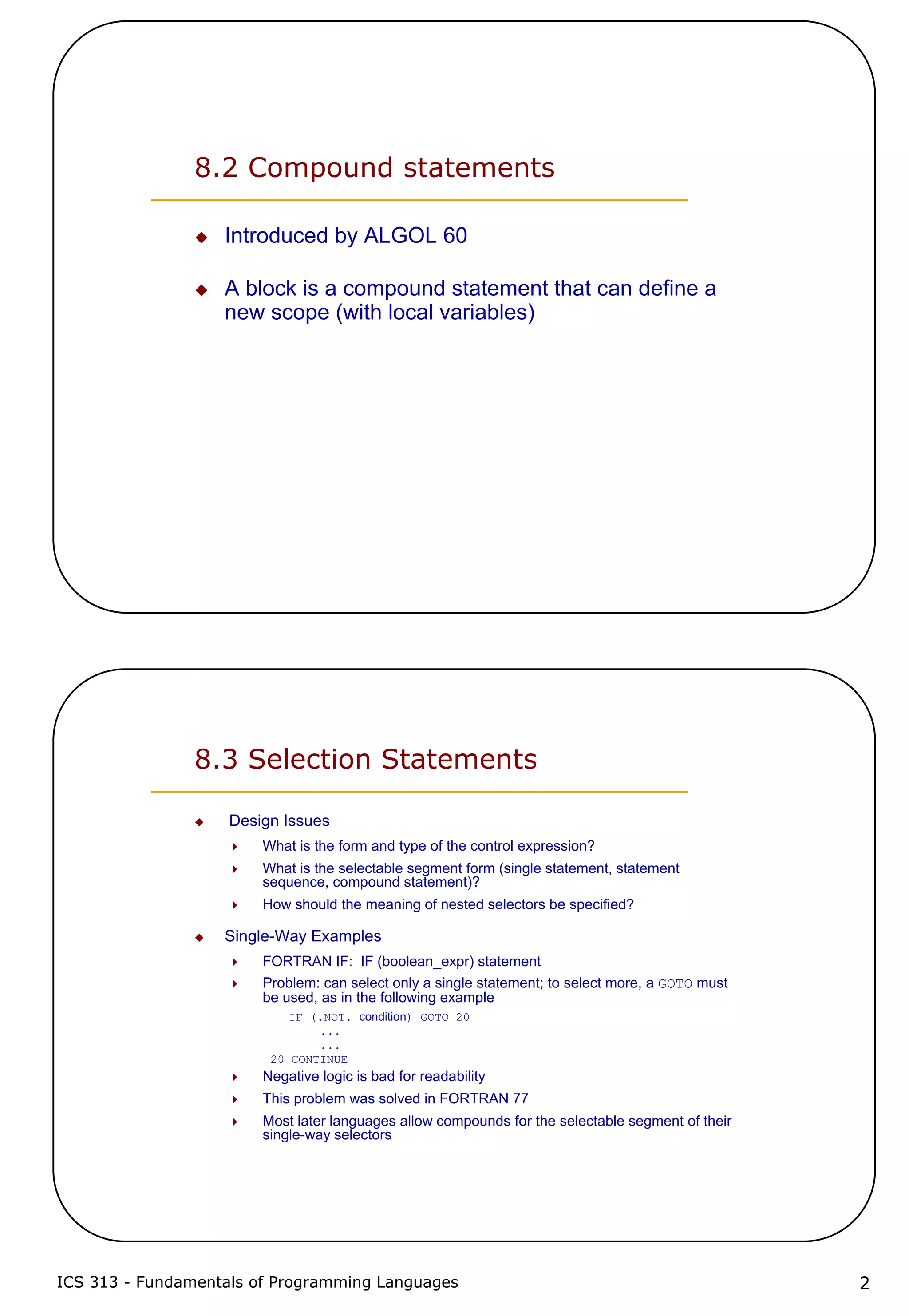
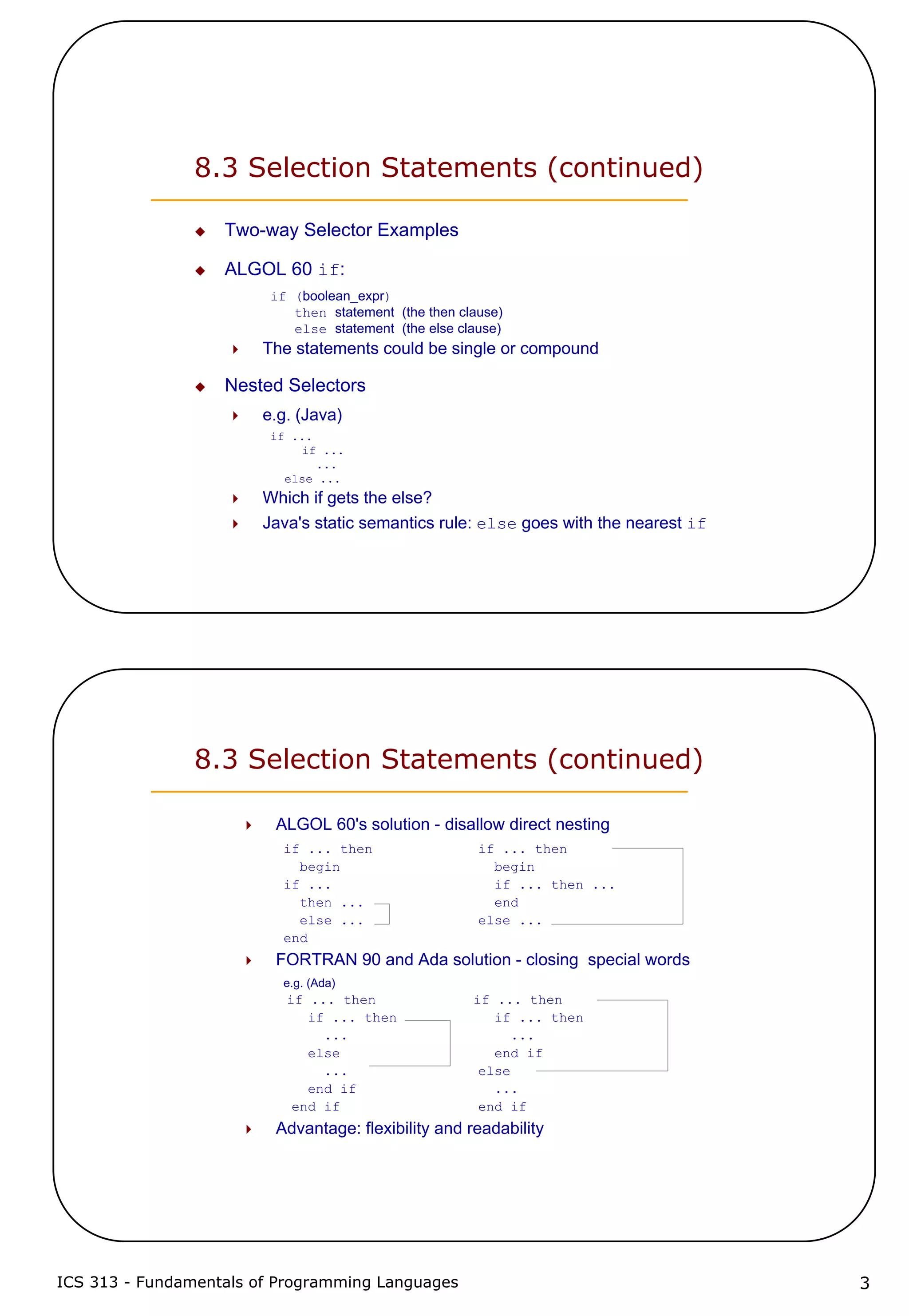
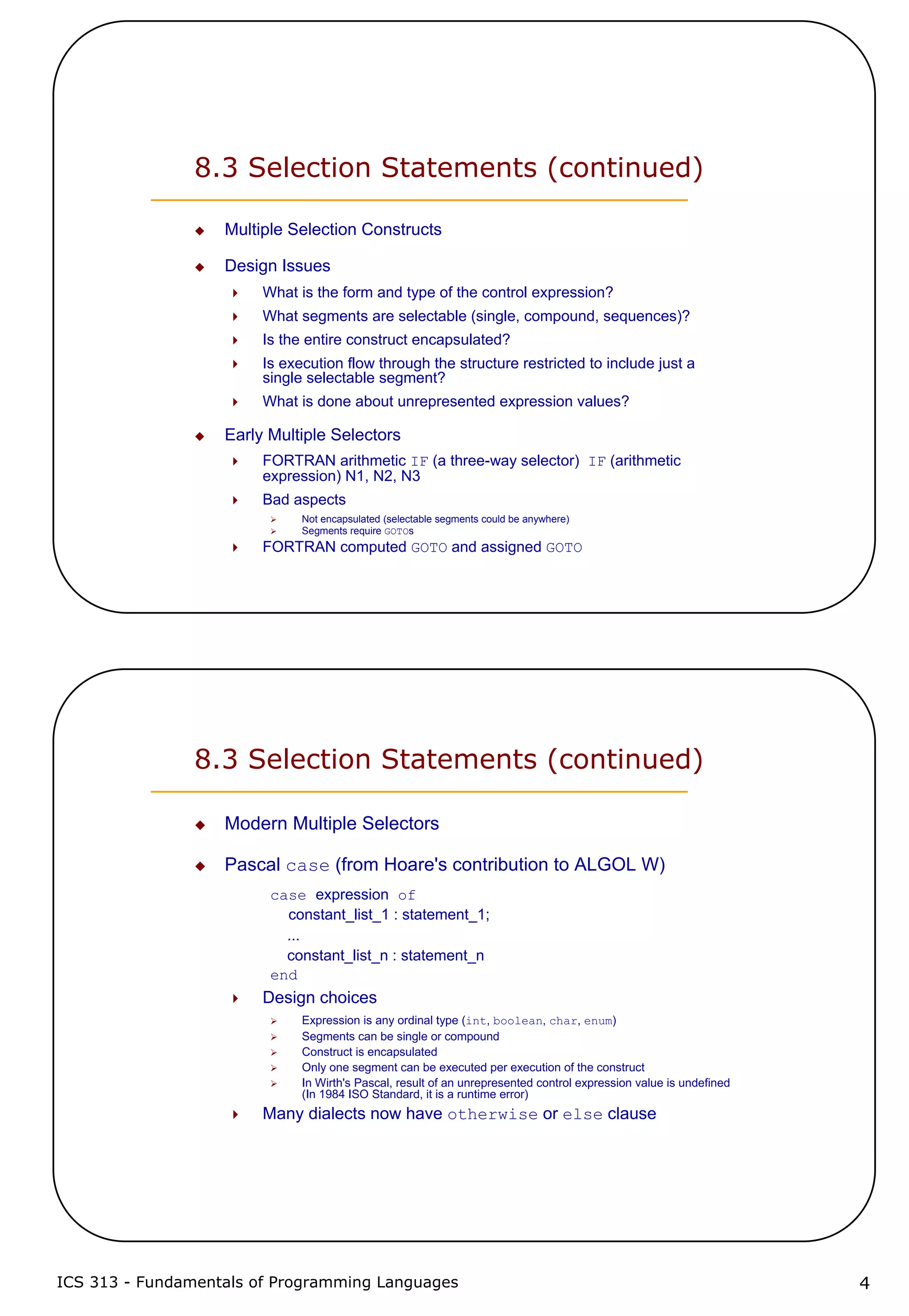
![ICS 313 - Fundamentals of Programming Languages 5
8.3 Selection Statements (continued)
The C, C++, and Java switch
switch (expression) {
constant_expression_1 : statement_1;
...
constant_expression_n : statement_n;
[default: statement_n+1]
}
Design Choices: (for switch)
Control expression can be only an integer type
Selectable segments can be statement sequences, blocks, or compound
statements
Construct is encapsulated
Any number of segments can be executed in one execution of the construct (there is
no implicit branch at the end of selectable segments) (a trade-off between reliability
and flexibility -- convenience)
To avoid it, the programmer must supply a break statement for each segment
default clause is for unrepresented values (if there is no default, the whole
statement does nothing)
8.3 Selection Statements (continued)
Ada's case is similar to Pascal's case, except:
Constant lists can include:
Subranges e.g., 10..15
Boolean OR operators
e.g., 1..5 | 7 | 15..20
Lists of constants must be exhaustive
Often accomplished with others clause
This makes it more reliable
Multiple Selectors can appear as direct extensions to two-way selectors, using
else-if clauses (ALGOL 68, FORTRAN 90, Ada)
Ada:
if ...
then ...
elsif ...
then ...
elsif ...
then ...
else ...
end if
Far more readable than deeply nested if's
Allows a Boolean gate on every selectable group](https://image.slidesharecdn.com/8-statement-levelcontrolstructure-130616234908-phpapp01/75/8-statement-level-control-structure-5-2048.jpg)
![ICS 313 - Fundamentals of Programming Languages 6
8.4 Iterative Statements
The repeated execution of a statement or compound statement is
accomplished either by iteration or recursion; here we look at
iteration, because recursion is unit-level control
General design Issues for iteration control statements
How is iteration controlled?
Where is the control mechanism in the loop?
Counter-Controlled Loops
Design Issues
What are the type and scope of the loop var?
What is the value of the loop var at loop termination?
Should it be legal for the loop var or loop parameters to be changed in
the loop body, and if so, does the change affect loop control?
Should the loop parameters be evaluated only once, or once for every
iteration?
8.4 Iterative Statements (continued)
FORTRAN 90
Syntax: DO label var = start, finish [, stepsize]
Stepsize can be any value but zero
Parameters can be expressions
Design choices:
Loop var must be INTEGER
Loop var always has its last value
The loop var cannot be changed in the loop, but the parameters can;
because they are evaluated only once, it does not affect loop control
Loop parameters are evaluated only once
FORTRAN 90’s Other DO
Syntax
[name:] DO variable = initial, terminal [, stepsize]
…
END DO [name]
Loop var must be an INTEGER](https://image.slidesharecdn.com/8-statement-levelcontrolstructure-130616234908-phpapp01/75/8-statement-level-control-structure-6-2048.jpg)
![ICS 313 - Fundamentals of Programming Languages 7
8.4 Iterative Statements (continued)
ALGOL 60
Syntax: for var := <list_of_stuff> do statement,
where <list_of_stuff> can have
list of expressions
expression step expression until expression
expression while boolean_expression
for index := 1 step 2 until 50,
60, 70, 80,
index + 1 until 100 do
(index = 1, 3, 5, 7, ..., 49, 60, 70, 80, 81, 82,
...,100)
ALGOL 60 Design choices
Control expression can be int or real; its scope is whatever it is
declared to be
Control var has its last assigned value after loop termination
The loop var cannot be changed in the loop, but the parameters can,
and when they are, it affects loop control
Parameters are evaluated with every iteration, making it very complex
and difficult to read
8.4 Iterative Statements (continued)
Pascal
Syntax:
for variable := initial (to | downto) final do statement
Design Choices
Loop var must be an ordinal type of usual scope
After normal termination, loop var is undefined
The loop var cannot be changed in the loop; the loop parameters can be changed, but they are
evaluated just once, so it does not affect loop control
Ada
Syntax:
for var in [reverse] discrete_range loop
...
end loop
Design choices
Type of the loop var is that of the discrete range; its scope is the loop body (it is implicitly
declared)
The loop var does not exist outside the loop
The loop var cannot be changed in the loop, but the discrete range can; it does not affect
loop control
The discrete range is evaluated just once](https://image.slidesharecdn.com/8-statement-levelcontrolstructure-130616234908-phpapp01/75/8-statement-level-control-structure-7-2048.jpg)
![ICS 313 - Fundamentals of Programming Languages 8
8.4 Iterative Statements (continued)
C
Syntax
for ([expr_1] ; [expr_2] ; [expr_3]) statement
The expressions can be whole statements, or even statement
sequences, with the statements separated by commas
The value of a multiple-statement expression is the value of the last
statement in the expression e.g.,
for (i = 0, j = 10; j == i; i++) …
If the second expression is absent, it is an infinite loop
Design Choices:
There is no explicit loop var
Irrelevant
Everything can be changed in the loop
The first expression is evaluated once, but the other two are evaluated with each iteration
This loop statement is the most flexible
8.4 Iterative Statements (continued)
C++
Differs from C in two ways:
The control expression can also be Boolean
The initial expression can include variable definitions (scope is from the
definition to the end of the loop body)
Java
Differs from C++ in that the control expression must be
Boolean](https://image.slidesharecdn.com/8-statement-levelcontrolstructure-130616234908-phpapp01/75/8-statement-level-control-structure-8-2048.jpg)
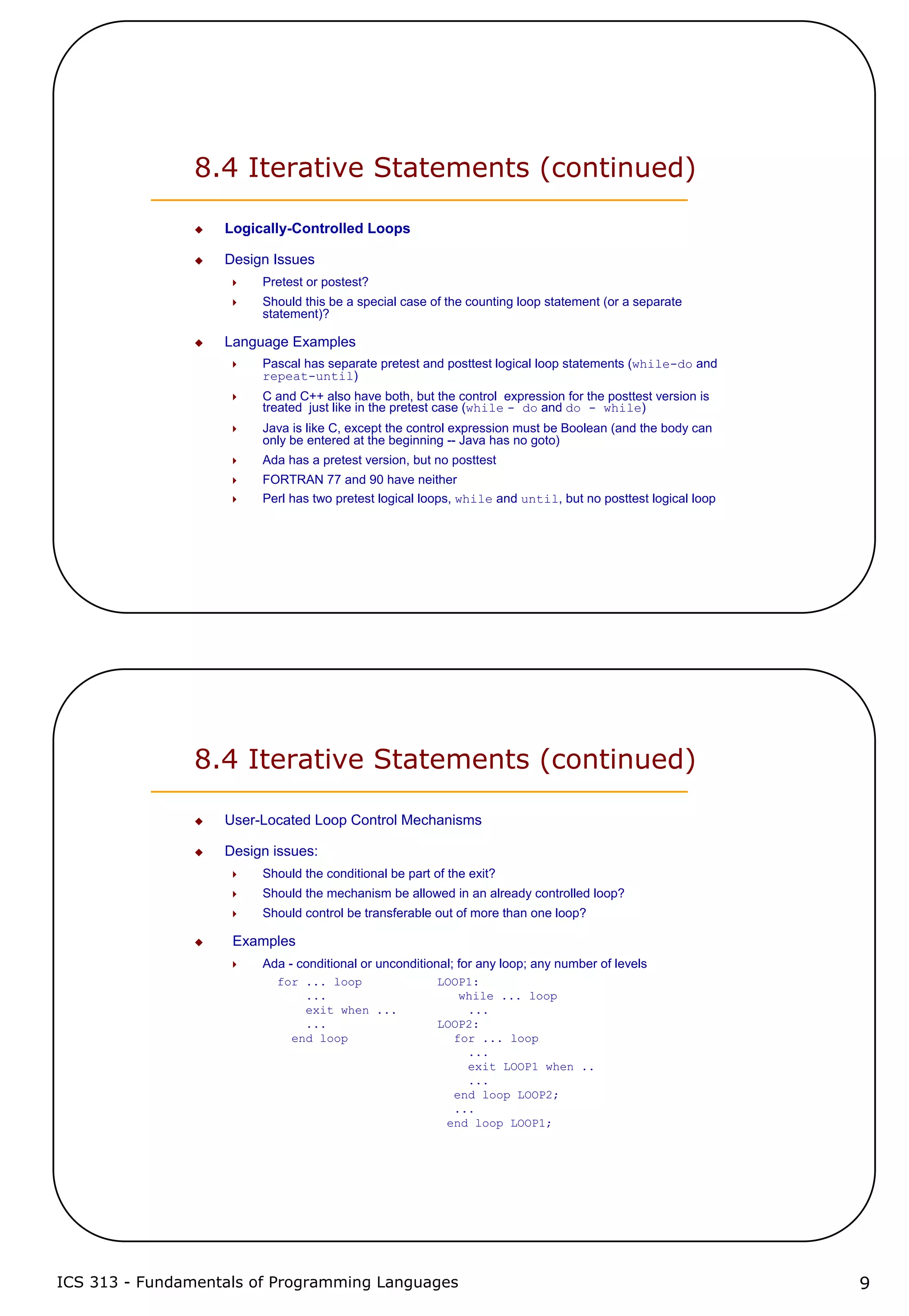
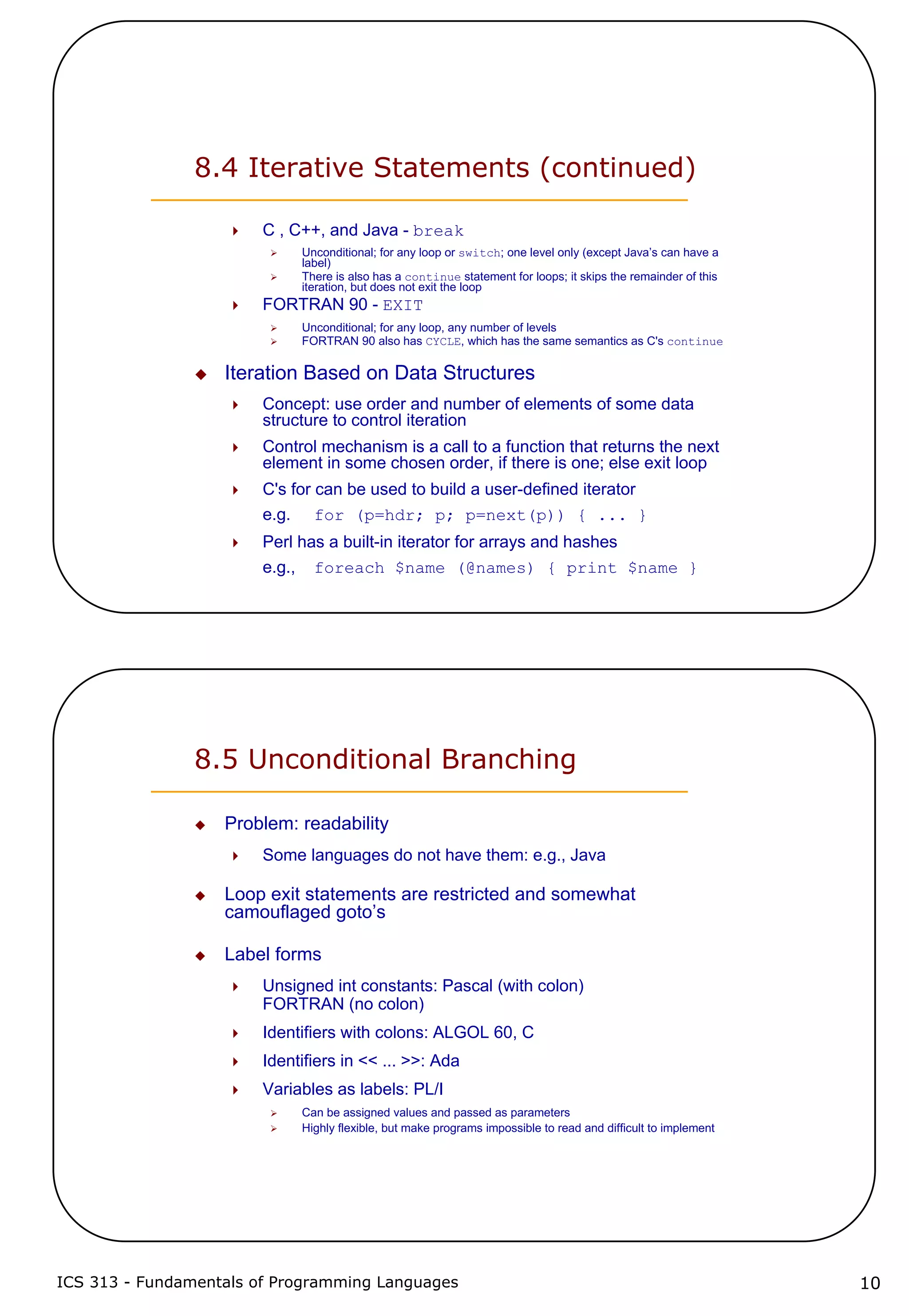
![ICS 313 - Fundamentals of Programming Languages 11
8.6 Guarded Commands
Dijkstra, 1975
Purpose: to support a new programming methodology (verification
during program development)
Selection: if <boolean> -> <statement>
[] <boolean> -> <statement>
...
[] <boolean> -> <statement>
fi
Semantics: when this construct is reached,
Evaluate all boolean expressions
If more than one are true, choose one nondeterministically
If none are true, it is a runtime error
Idea: if the order of evaluation is not important, the program should not
specify one
See book examples (pp. 339, 340)
8.6 Guarded Commands (continued)
Loops do <boolean> -> <statement>
[] <boolean> -> <statement>
...
[] <boolean> -> <statement>
od
Semantics: For each iteration
Evaluate all boolean expressions
If more than one are true, choose one nondeterministically; then start loop again
If none are true, exit loop
--> See book example (p. 340)
Connection between control statements and program verification is intimate
Verification is impossible with gotos
Verification is possible with only selection and logical pretest loops
Verification is relatively simple with only guarded commands
Chapter Conclusion: Choice of control statements beyond selection and logical
pretest loops is a trade-off between language size and writability](https://image.slidesharecdn.com/8-statement-levelcontrolstructure-130616234908-phpapp01/75/8-statement-level-control-structure-11-2048.jpg)